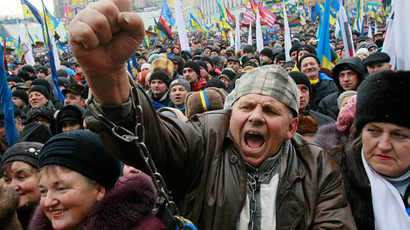From Russian invasion to colored Statue of Liberty: Hoaxes fuel Ukrainian protest
Although they have lasted for two weeks, the protests in Ukraine are far from losing their steam. Among the things keeping the crowd’s anger alive are media hoaxes. With tensions running high in Kiev, their consequences are ever harder to predict.
Having to endure freezing temperatures on the streets of Kiev is not the worst the protesters and police have been through since the rallies broke out in the Ukrainian capital in late November, following President Yanukovich’s refusal to sign an integration agreement with the EU.
A violent crackdown on the rally participants by the Berkut special police forces on the night of November 30, instead of suffocating the protest only multiplied the number of its participants and strengthened their resolve.
Standoffs between police and protesters have become a daily routine for the Ukrainian capital, which is looking like a war zone with its camp of protesters in the very center and barricades around major government buildings. Each side claims dozens of injured in the clashes.
“Every few hours Ukraine’s opposition reports police have begun an assault on the protesters, so every few hours the tension is ratcheted up another notch,” RT’s Paul Scott reports from Kiev.
In a situation as precarious as this, any news might become explosive - fertile ground for hoaxing.
Like the one, that emerged straight after the December-6 meeting between Viktor Yanukovich’s and Vladimir Putin. Media reported that the Ukrainian president had agreed to join Russia's Customs Union. The reports hardened the resolve of many on Independence Square (Maidan Nelalezhnosti).

The story was immediately denied by Moscow and Kiev, but among the protesters it fell on deaf ears.
The rumor of the Russia-Ukraine agreement was followed by more outrageous ones. One minute it was claimed that Russia was going to cross the border and help stamp out the protests. The next stated that special forces were being shipped in from all over Ukraine, and tanks were rumbling their way into central Kiev.
Mark Almond, Professor of history at Oxford University told RT, that he had seen it all before.
“Those who remember the so-called orange revolution in 2004 would remember we were told then that there were Russian special forces lurking in the woods near Kiev, waiting to crack down. There weren’t, nothing happened,” Almond said. “So we’re seeing a kind of a propaganda war… psychological war taking place, using these rumors of crackdown and even foreign interference”.
On Monday, several Ukrainian news outlets reported on foreign countries’ acts of support for the protesters out on the streets of Kiev. It was said that Washington’s Statue of Liberty and Rio’s Statue of Christ the Redeemer had been lit up by blue and yellow lights, representing the colors of the Ukrainian flag. The pictures of the events jumped from a personal Facebook account to the official Twitter of a major opposition political party and then to news agencies.
Only it wasn’t news. Rather an experiment to show how easy it was to manipulate public opinion. The pictures were actually photoshoped by a Ukrainian blogger and occasional online prankster, Den Alampiev.

“I decided to see how people are consuming hoax news,” he wrote on his web-page. “It took me two minutes to make fake photos of the Statue of Liberty and the Statue of Christ. I wrote a short description and posted on Facebook, Vkontakte [famous Russian network], Twitter and LJ. In exactly 24 hours the photo spread across the social media.”
The effect actually exceeded Den’s expectations. Hundreds of Facebook likes were one thing, but the “lighting trick” soon led to a much more serious result.
"It was even retweeted on the official twitter page of the opposition party Fatherland as real news, with a comment that the whole world is supporting Ukrainian protesters”, Alampiev told RT.
“People camping out on Maidan don't check this information. Such hoaxes are spread to instigate people, not to let protesters run out of steam, to draw more support for a certain political power.”
For more on the fake news, which adds fuel to protests in Kiev, watch RT Paul Scott’s report from the Ukrainian capital.














